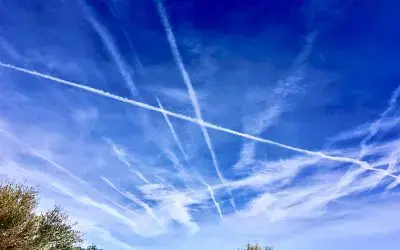11-11-2025
I never knew what to think of this topic, chemtrails or contrails, or the stripes in the sky that linger after airplanes pass. I don't remember them as a child. They're very common now.
Wyoming State Legislature discussion on Geoengineering...
Dane Wigington is the lead researcher and founder of GeoengineeringWatch, dedicated to exposing and halting covert climate engineering operations. With a professional background in solar energy, including work with Bechtel Power Corporation and licensure as a contractor. Wigington's interest in geoengineering intensified after observing significant declines in solar energy collection at his home. This prompted extensive research into atmospheric aerosol spraying and its environmental impacts. He has since become a prominent voice in raising awareness about geoengineering.
Chemtrails Exposed: A New Manhattan Project
They say that the lines in the sky are harmless condensation trails and that jet aircrafts have always produced emissions that can linger in the sky for hours as they spread out and form a hazy cloud-cover. They say that anybody who asserts that aircraft are routinely spraying us with toxic materials is crazy. If this is so, then why are we consistently seeing anomalously high levels of toxins in rainwater samples as well as in ambient air samples? Why are there hundreds of scientists and scores of scientific organizations advocating for spraying substances from aircraft and calling it "geoengineering?" ...
At least as far back as the 1990s, concerned citizens had started to notice white trails that stretched across and dimmed the sky, diffusing briefly to resemble cirrus clouds before making a white haze. Dubbed chemtrails, jet-emplaced particulate trails have been observed to be increasing in frequency, geographic range, and intensity for more than two decades becoming a near-daily, near-global occurrence. What substances are being jet-sprayed to form the trails? Why is this being done? What are the risks to human and environmental health? What is the legal justification? Inquiries to authorities inevitably were met with the same scientifically invalid response, namely, these are contrails, harmless ice crystals from jet’s exhaust. Book.
Coal combustion products (CCPs), also called coal combustion wastes (CCWs) or coal combustion residuals (CCRs), are byproducts of burning coal. Categorized in four groups.
Fly ash is captured after coal combustion by filters (bag houses), electrostatic precipitators and other air pollution control devices. It comprises 60 percent of all coal combustion waste.
It is most commonly used as a high-performance substitute for Portland cement .Building material applications range from grouts and masonry products to cellular concrete and roofing tiles. Many asphaltic concrete pavements contain fly ash.
Overview
Geoengineering, also known as climate engineering, refers to the deliberate large-scale manipulation of Earth's systems to counteract the effects of climate change
It is typically discussed as a potential technological solution to address the symptoms of climate change, although it doesn't tackle the root causes, such as greenhouse gas emissions.
- Carbon Dioxide Removal (CDR): These techniques aim to remove carbon dioxide (CO2) from the atmosphere and store it in long-term reservoirs.
- Examples include afforestation and reforestation, which utilize trees to absorb CO2, and direct air capture (DAC) technologies that mechanically remove CO2.
- Solar Radiation Management (SRM): Also known as solar geoengineering, these methods seek to reflect sunlight away from Earth, thus reducing the amount of solar energy absorbed by the planet and counteracting the warming effects of greenhouse gases.
- Examples include stratospheric aerosol injection (SAI), which involves introducing reflective particles into the upper atmosphere, and marine cloud brightening (MCB), which aims to increase the reflectivity of low-lying clouds over the oceans.
- Unintended consequences: Large-scale interventions in Earth's systems could have unforeseen and potentially harmful environmental and social impacts.
- Termination shock: A sudden halt to SRM deployment could lead to a rapid and potentially catastrophic rise in global temperatures.
- Governance and ethical challenges: Geoengineering raises significant ethical questions about who decides when and how to deploy these technologies, and how to address potential conflicts between different countries' interests.
- Does not address root causes: SRM techniques do not address the underlying problem of greenhouse gas emissions and could create a "moral hazard" by reducing the urgency to cut emissions.
31 U.S. states have introduced legislation to ban or severely limit geoengineering and weather modification operations.
Large-scale interventions in Earth's systems could have unforeseen and potentially harmful environmental and social impacts.






